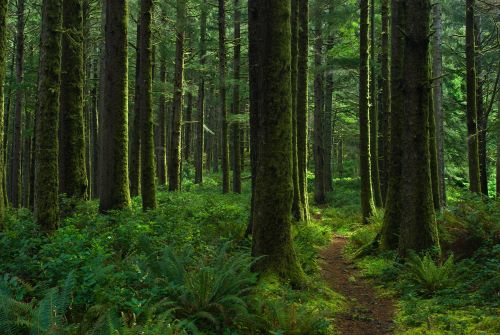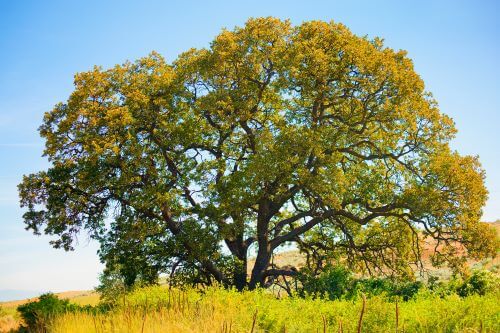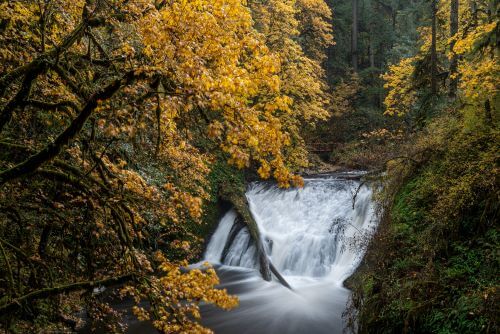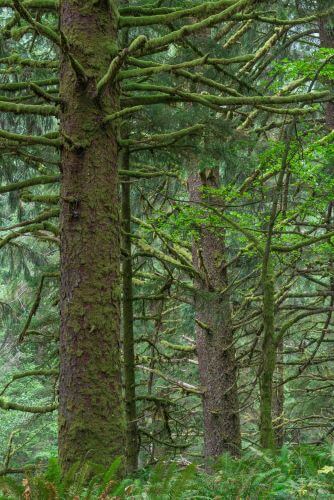
Work. Play. Renew.
5 Types of Trees for Which Oregon Is Known
Oregon is a land of diverse flora, with a vast array of trees spread across its varying landscapes, from the Pacific coast to the Cascade Range and the arid eastern Oregon region. The state’s forests cover more than 30 million acres, and its temperate climate and fertile soil make it home to some of the coolest trees in the world. These conditions make it one of the most forested states in the entire country. In this article, we’ll explore five types of Oregon trees for which the state is known.

1. Douglas-fir (Pseudotsuga menziesii)
The Douglas-fir is Oregon’s most iconic tree of the Pacific Northwest, and it is the state tree of Oregon. It’s a towering coniferous evergreen that can grow up to 330 feet tall and live for more than 1,000 years. The tree has a conical shape, with a straight trunk and thick, dark green needles. Its cones have a distinctive three-pointed bract that extends out from each scale, like a mouse that is burying its head. Douglas-fir are a sun-loving species and are extremely shade intolerant. They evolved to thrive in sunny, open-canopy sections of the forest often created after disruptive weather events like fire or wind.
The Douglas-fir is a valuable source of timber for the state, with wood highly sought after for its strength and durability, making it extremely valuable in construction. It is the highest-yielding timber species in North America and is a direct contributor to making the forests of the Pacific Northwest the most productive in the nation.
Douglas-fir is the most dominant species in Oregon’s west-side forests and is a vital part of the state’s ecosystem. It provides shelter and food for a variety of wildlife, including elk, deer, and black bears.

2. Western Hemlock (Tsuga heterophylla)
Western hemlock is another iconic tree of the Pacific Northwest, and it is the state tree of Washington. It can grow up to 230 feet tall and has a narrow, conical shape. The tree has small, flat needles that are a yellow-green color and produce cones that are about one inch long. It is easily recognized by its iconic gently bending leader at the top of each tree. It’s incredibly shade tolerant and will often grow under the bows of other trees, where it can wait for decades before exploiting a gap in the canopy. It is very common the closer you get to the Pacific Ocean, often becoming the dominant species in forests growing adjacent to the ocean.
Western hemlock wood is soft and lightweight, making it ideal for paper products and some forms of light construction. The tree is also an important food source for wildlife, with its needles and twigs providing sustenance for deer and elk during the winter months. When not used as a softwood for production, it is often planted as an ornamental tree in Oregon and along the Pacific Northwest.

3. Oregon White Oak (Quercus garryana)
Oregon white oak is native to the Willamette Valley in western Oregon. It can grow up to 100 feet tall and has a broad, spreading crown. The white oak is a slow-growing tree that can live for centuries, with some trees in the state estimated to be more than 400 years old. The tree has large, lobed leaves that turn a bright red in the fall, and it produces acorns, which are an important food source for wildlife. It is the only native oak found in the Pacific Northwest.
The Oregon white oak is an important tree for Oregon’s ecosystem and is commonly found in savannah habitats, where it provides shelter and food for a variety of wildlife and insects. The tree is also an important source of wood, with its strong, dense timber used for furniture and flooring.

4. Bigleaf Maple (Acer macrophyllum)
The bigleaf maple is native to the Pacific Northwest and can grow up to 100 feet tall and has a broad, spreading crown. The tree has large, bright green lobed leaves that can be up to 12 inches wide, and it produces clusters of small, yellow-green flowers in the spring. They turn a striking yellow color in the fall. It is common in Oregon’s moist coastal regions.
This species is the only commercially viable maple tree in Oregon. Bigleaf maple wood is hard and dense, yet much lighter weight than its cousin the white oak, making it ideal for furniture and other decorative items. It’s prized for its curly grain and can be utilized in making musical instruments. The tree is also an important source of food for wildlife, with the sap and leaves providing sustenance for a variety of insects and birds and providing a habitat for those and all kinds of other animals.

5. Sitka Spruce (Picea sitchensis)
The Sitka spruce is a coniferous tree native to the Pacific Northwest. It can grow up to 330 feet tall and has a narrow, conical shape. The tree has needles that are a blue-green color, and these trees produce cones that are up to four inches long.
Sitka spruce wood is strong and lightweight, making it ideal for boat building and other construction projects. Its rapid growth combined with its long life span and ability to grow in poor soil make it a staple of the lumber industry. The tree is also an important source of food and shelter for wildlife, with the needles providing sustenance for deer and elk during the winter months.
Oregon is known for its incredible variety of native trees, and these five species are some of the most iconic and important. From the towering Douglas-fir to the broad-spreading Oregon white oak, each has its own unique characteristics and importance to the state’s ecosystem and economy. From the proud western hemlock to the colorful bigleaf maple, Oregon trees are a vital part of its natural heritage and a continuous source of pride for its residents. These towering plants are also responsible for employing nearly 1.5 percent of Oregon’s residents, working together for the state and for the trees. When we work together, we can manage and care for Oregon Forests Forever.
[/et_pb_text][et_pb_code _builder_version=”4.19.2″ _module_preset=”default” hover_enabled=”0″ sticky_enabled=”0″][/et_pb_code][/et_pb_column][/et_pb_row][/et_pb_section]